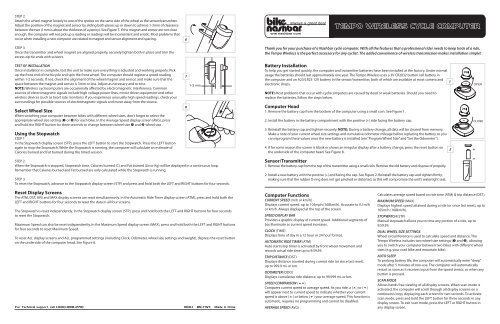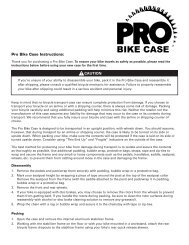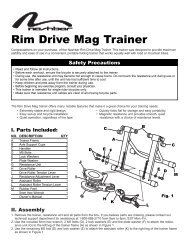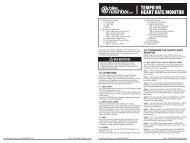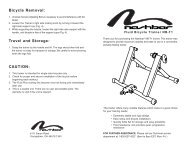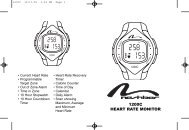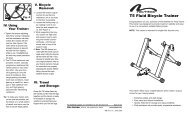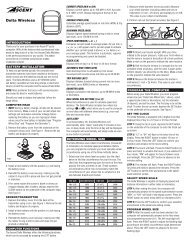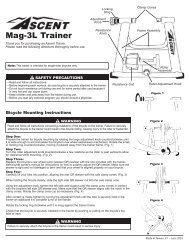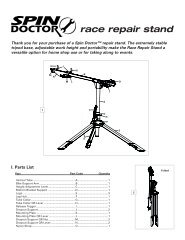TEMPO WIRELESS CYCLE COMPUTER - Nashbar
TEMPO WIRELESS CYCLE COMPUTER - Nashbar
TEMPO WIRELESS CYCLE COMPUTER - Nashbar
Create successful ePaper yourself
Turn your PDF publications into a flip-book with our unique Google optimized e-Paper software.
STEP 2<br />
Attach the wheel magnet loosely to one of the spokes on the same side of the wheel as the sensor/transmitter.<br />
Adjust the position of the magnet and sensor by sliding both pieces up or down to achieve 1-3mm of clearance<br />
between the two (1mm is about the thickness of a penny). See Figure 7. If the magnet and sensor are not close<br />
enough, the computer will not pick up a reading or readings will be inconsistent and erratic. Most problems that<br />
occur when installing a new computer are related to magnet and sensor alignment and spacing.<br />
6<br />
always a great deal<br />
<strong>TEMPO</strong> <strong>WIRELESS</strong> <strong>CYCLE</strong> <strong>COMPUTER</strong><br />
STEP 3<br />
Once the transmitter and wheel magnet are aligned properly, securely tighten both in place and trim the<br />
excess zip-tie ends with scissors.<br />
TEST OF INSTALLATION<br />
Once installation is complete, test the unit to make sure everything is adjusted and working properly. Pick<br />
up the front end of the bicycle and spin the front wheel. The computer should register a speed reading<br />
within 1-2 seconds. If not, check the alignment of the wheel magnet and sensor, and make sure that the<br />
space between the magnet and sensor is 3mm or less. Adjust as necessary and re-test.<br />
NOTE: Wireless cyclocomputers are occasionally affected by electromagnetic interference. Common<br />
sources of electromagnetic signals include high voltage power lines, motor driven equipment and other<br />
wireless devices (such as heart rate monitors). If you experience unusually high speed readings, check your<br />
surroundings for possible sources of electromagnetic signals and move away from the source.<br />
Select Wheel Size<br />
When switching your computer between bikes with different wheel sizes, don’t forget to select the<br />
appropriate wheel size setting (➊ or ➋) for each bike. In the Average Speed display screen (AVG), press<br />
and hold the RIGHT button for three seconds to change between wheel size ➊ and ➋ wheel size .<br />
Using the Stopwatch<br />
STEP 1<br />
In the Stopwatch display screen (STP), press the LEFT button to start the Stopwatch. Press the LEFT button<br />
again to stop the Stopwatch. While the Stopwatch is running, the computer will calculate an estimate of<br />
Calories burned and Fat burned during the timed session.<br />
7<br />
8<br />
Thank you for your purchase of a <strong>Nashbar</strong> cycle computer. With all the features that a professional rider needs to keep track of a ride,<br />
the Tempo Wireless is the perfect accessory for any cyclist. The added convenience of wireless transmission makes installation simple!<br />
Battery Installation<br />
To help you get started quickly, the computer and transmitter batteries have been installed at the factory. Under normal<br />
usage the batteries should last approximately one year. The Tempo Wireless uses a 3V CR2032 button cell battery in<br />
the computer and an A23/LR23 12V battery in the sensor/transmitter, both of which are available at most camera and<br />
electronic shops.<br />
NOTE: Most problems that occur with cyclocomputers are caused by dead or weak batteries. Should you need to<br />
replace the batteries, follow the steps below.<br />
Computer Head<br />
1. Remove the battery cap from the bottom of the computer using a small coin. See Figure 1.<br />
2. Install the battery in the battery compartment with the positive (+) side facing the battery cap.<br />
3. Reinstall the battery cap and tighten securely. NOTE: During a battery change, all data will be cleared from memory.<br />
Make a note of your current wheel size settings and cumulative odometer mileage before replacing the battery so you<br />
can reprogram these values once the new battery is installed (see “Program Wheel Size” and “Set the Odometer”).<br />
4. If for some reason the screen is blank or shows an irregular display after a battery change, press the reset button on<br />
the underside of the computer head. See Figure 8.<br />
1<br />
2<br />
STEP 2<br />
When the Stopwatch is stopped, Stopwatch time, Calories burned (C) and Fat burned (Lb or Kg) will be displayed in a continuous loop.<br />
Remember that Calories burned and Fat burned are only calculated while the Stopwatch is running.<br />
STEP 3<br />
To reset the Stopwatch, advance to the Stopwatch display screen (STP) and press and hold both the LEFT and RIGHT buttons for four seconds.<br />
Sensor/Transmitter<br />
1. Remove the battery cap from the top of the transmitter using a small coin. Remove the old battery and dispose of properly.<br />
2. Install a new battery with the positive (+) end facing the cap. See Figure 2. Reinstall the battery cap and tighten firmly,<br />
making sure that the rubber O-ring does not get pinched or distorted, as this will compromise the unit’s watertight seal.<br />
Reset Display Screens<br />
The ATM, DST, AVS and MAX display screens are reset simultaneously. In the Automatic Ride Timer display screen (ATM), press and hold both the<br />
LEFT and RIGHT buttons for four seconds to reset the data in all four screens.<br />
The Stopwatch is reset independently. In the Stopwatch display screen (STP), press and hold both the LEFT and RIGHT buttons for four seconds<br />
to reset the Stopwatch.<br />
Maximum Speed can also be reset independently. In the Maximum Speed display screen (MAX), press and hold both the LEFT and RIGHT buttons<br />
for four seconds to reset Maximum Speed.<br />
To reset ALL display screens and ALL programmed settings (including Clock, Odometer, wheel size settings and weight), depress the reset button<br />
on the underside of the computer head. See Figure 8.<br />
For Technical support, call 1-800-888-2710 1108-1 BN-TWC Made in China<br />
Computer Functions<br />
CURRENT SPEED (m/h or km/h)<br />
Displays current speed, up to 105mph (168km/h). Accurate to 0.1m/h<br />
or km/h. Always displayed at the top of the screen.<br />
SPEED DISPLAY BAR<br />
Provides a graphic display of current speed. Additional segments of<br />
bar illuminate as current speed increases.<br />
CLOCK (TIME)<br />
Displays time of day in a 12 hour or 24 hour format.<br />
AUTOMATIC RIDE TIMER (ATM)<br />
Auto start/stop timer is activated by front wheel movement and<br />
records actual ride time up to 9:59:59.<br />
TRIP DISTANCE (DST)<br />
Displays distance traveled during current ride (or since last reset),<br />
up to 999.9 mi. or km.<br />
ODOMETER (ODO)<br />
Displays cumulative ride distance, up to 99,999 mi. or km.<br />
SPEED COMPARISON (56)<br />
Compares current speed to average speed. As you ride, a (5) or (6)<br />
will appear next to current speed to indicate whether your current<br />
speed is above (5) or below (6) your average speed. This function is<br />
automatic, requires no programming and cannot be disabled.<br />
AVERAGE SPEED (AVG)<br />
Calculates average speed based on ride time (ATM) & trip distance (DST).<br />
MAXIMUM SPEED (MAX)<br />
Displays highest speed attained during a ride (or since last reset), up to<br />
105m/h (168km/h).<br />
STOPWATCH (STP)<br />
Manual stopwatch allows you to time any portion of a ride, up to<br />
9:59:59.<br />
DUAL WHEEL SIZE SETTINGS<br />
Wheel circumference is used to calculate speed and distance. The<br />
Tempo Wireless includes two wheel size settings (➊ and ➋), allowing<br />
you to switch your computer between two bikes with different wheel<br />
sizes (e.g. your road bike and mountain bike).<br />
AUTO SLEEP<br />
To prolong battery life, the computer will automatically enter “sleep”<br />
mode after 5 minutes of non-use. The computer will automatically<br />
restart as soon as it receives input from the speed sensor, or when any<br />
button is pressed.<br />
SCAN MODE<br />
Allows hands free viewing of all display screens. When scan mode is<br />
activated, the computer will scroll through all display screens on a<br />
continuous loop, displaying each screen for two seconds. To activate<br />
scan mode, press and hold the LEFT button for three seconds in any<br />
display screen. To exit scan mode, press the LEFT or RIGHT button in<br />
any display screen.
Determine Wheel Size<br />
The Tempo computer uses wheel circumference (measured in millimeters) to calculate<br />
speed and distance. Before you can program the computer you must calculate wheel<br />
circumference using one of the three methods below.<br />
1. Select size from chart (least accurate): Use the chart at right to find the circumference<br />
for your tire size. The chart lists the programming sizes for some of the most popular tire<br />
sizes currently in use. These numbers are estimations which may not precisely match the<br />
circumference of your wheel, due to variations in tire size between brands and models.<br />
2. Measure wheel diameter (more accurate): Measure your wheel diameter (including wheel<br />
and tire) in millimeters (1 inch = 25.4mm) and multiply by 3.1416. This value is your wheel<br />
circumference.<br />
3. Perform roll-out test (most accurate): See Figure 3.<br />
STEP 1<br />
Stand your bicycle upright. With your tire inflated to its proper pressure, rotate your front<br />
wheel so that the valve is located at the bottom (6 o’clock position). Make a mark on the<br />
floor to indicate the valve location.<br />
3<br />
(SET THE ODOMETER)<br />
STEP 8<br />
After programming wheel size, the computer will automatically advance to the odometer setting screen. (If you don’t want to change the<br />
odometer setting, press the RIGHT button five times to exit the set-up mode.) The digit at the right of the screen will flash. Press the LEFT button<br />
to adjust the value. Press the RIGHT button to advance to the next flashing digit.<br />
STEP 9<br />
Repeat this sequence until the odometer has been set to the appropriate value. Then press the RIGHT button to exit the set-up mode and return<br />
to the Odometer display screen.<br />
Input Weight<br />
The Tempo computer uses body weight to estimate calories and fat burned during a ride.<br />
STEP 1<br />
Press the RIGHT button to advance to the Stopwatch display screen (STP). In the STP screen press and hold the RIGHT button for three seconds.<br />
“Lb” or “Kg” will flash in the lower line of the display. Press the LEFT button to select pounds (Lb) or Kilograms (Kg). Press the RIGHT button to<br />
confirm your selection and advance to the weight input screen.<br />
STEP 2<br />
The right digit will flash. Press the LEFT button to adjust the value. Press the RIGHT button to advance to the next flashing digit.<br />
STEP 2<br />
Roll the bicycle forward in a straight line for one complete wheel revolution, until the valve is again at the bottom (ideally, you should be on the<br />
bike). Make a mark on the floor to indicate the valve location.<br />
STEP 3<br />
Measure the distance between the marks in millimeters<br />
(1 inch = 25.4mm). This value is your wheel circumference.<br />
Program the Computer<br />
Before using your Tempo computer, you must program wheel size (see “Determine Wheel Size,” above), select a speed scale (miles or kilometers),<br />
set the odometer (if desired), input your weight and set the clock. The first step is to select the speed scale.<br />
Select Miles or Kilometers, Program Wheel Size<br />
& Set the Odometer<br />
Your computer is capable of displaying speed and distance information in either miles or kilometers. Also, the odometer can be set so that<br />
cumulative mileage can be restored after a battery change or transferred from another computer.<br />
(SELECT MILES OR KILOMETERS)<br />
STEP 1<br />
Press the RIGHT button to advance to the Odometer display screen (ODO). In the ODO screen, press and hold the RIGHT button for<br />
three seconds.<br />
STEP 2<br />
“km/h” or “m/h” will appear on the right side of the screen. Press the LEFT button to select miles (m/h) or kilometers (km/h).<br />
STEP 3<br />
Press the RIGHT button to confirm your selection and advance to the wheel size setting screen.<br />
(PROGRAM WHEEL SIZE)<br />
STEP 4<br />
After the speed scale has been selected, the computer will automatically advance to the first wheel size programming screen (➊). The digit at the<br />
right of the screen will flash. Press the LEFT button to adjust the flashing digit according to the wheel circumference value determined above.<br />
Press the RIGHT button to advance to the next flashing digit.<br />
STEP 5<br />
Repeat this sequence until the correct wheel size has been entered. Then press the RIGHT button to advance to the second wheel size<br />
setting screen (➋).<br />
STEP 6<br />
The digit at the right of the screen will flash. Press the LEFT button to adjust the flashing digit. Press the RIGHT button to advance to the next<br />
flashing digit.<br />
STEP 7<br />
Repeat this sequence until the second wheel size has been entered. Then press the RIGHT button to advance to the odometer setting screen.<br />
STEP 3<br />
Repeat this sequence until you have entered your correct weight. Then press the RIGHT button to exit the set-up mode and return to the<br />
Stopwatch display screen.<br />
Set the Clock<br />
Your computer is equipped with a digital clock that displays time of day in a 12 hour or 24 hour format.<br />
STEP 1<br />
Press the RIGHT button to advance to the Clock display screen (TIME). In the TIME screen, press and hold the RIGHT button for three seconds.<br />
STEP 2<br />
“12” or “24” will flash in the lower line of the display. Press the LEFT button to select 12 hour or 24 hour mode. Press the RIGHT button to confirm<br />
your selection and advance to the hours setting.<br />
STEP 3<br />
The hours will flash. Press the LEFT button (or press and hold) to advance the hours. Press the RIGHT button to advance to the minutes setting.<br />
STEP 4<br />
The minutes will flash. Press the LEFT button (or press and hold) to advance the minutes. Press the RIGHT button to set the time and return to the<br />
Clock display screen.<br />
Installation<br />
Since the computer is wireless, installation is simple and straight forward. Begin by attaching the computer<br />
mounting bracket to the handlebar<br />
BRACKET INSTALLATION<br />
Remove the backing from the small, adhesive rubber pad and apply the pad to the underside of the<br />
mounting bracket. Use the included zip-ties to attach the bracket to the handlebar as shown in Figure 4.<br />
Once the bracket is securely installed, trim the excess zip-tie ends with scissors.<br />
<strong>COMPUTER</strong> HEAD INSTALLATION<br />
Place the computer head in the bracket and twist the head clockwise until you hear a ‘CLICK’, indicating<br />
that the unit is locked in the bracket. See Figure 5. To remove the computer head, twist the head<br />
counterclockwise and then lift it out of the bracket.<br />
WHEEL MAGNET AND SENSOR INSTALLATION<br />
STEP 1<br />
Using the included rubber shim and zip-ties, loosely mount the sensor (so that you can slide it around) to the 5<br />
fork blade so that it’s on the same side of the bike as the handlebar bracket. The sensor/transmitter battery cap<br />
should face up. See Figure 6. The Tempo Wireless transmission range is 24” (60cm). The sensor/transmitter must<br />
be mounted within 24” of the receiver (computer head) in order for the receiver to pick up the signal.<br />
NOTE: We recommend mounting the sensor to the front (leading) edge of the fork blade to avoid problems should the sensor ever come into<br />
contact with the spokes.<br />
4


